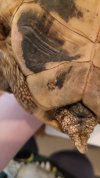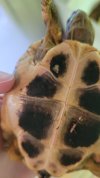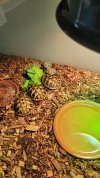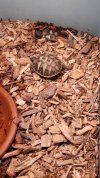Hi there everyone. I have come across this forum many times and read lots of posts, however I have never had a need to post until now.
To preface, I have read all the shell related questions, but would still like some opinions. I am feeling like a bad tortoise keeper this month. I lost a 3 month old hatchling to unknown causes and found a few of my torts to have some questionable marks on their shells. I haven't been able to take care of my torts much this year due to on and off illnesses that I have had, so the care has fallen to my husband and he is still learning.
So here's the situation. I have 2 sets of hatchlings that live together. 1 ground hatched in September and the other in November. A couple of weeks ago an individual from the November hatching died suddenly with no prior symptoms. Now today I noticed some marks on the plastrons of 2 of the September individuals. For the picture of the baby with the spot in the upper leg region, ignore the substrate on the lower belly.
Plus last night my husband found some damage to the plastron of my adult females. Her plastron really looks to be shell rot. For the babies, I'm not so sure.



To preface, I have read all the shell related questions, but would still like some opinions. I am feeling like a bad tortoise keeper this month. I lost a 3 month old hatchling to unknown causes and found a few of my torts to have some questionable marks on their shells. I haven't been able to take care of my torts much this year due to on and off illnesses that I have had, so the care has fallen to my husband and he is still learning.
So here's the situation. I have 2 sets of hatchlings that live together. 1 ground hatched in September and the other in November. A couple of weeks ago an individual from the November hatching died suddenly with no prior symptoms. Now today I noticed some marks on the plastrons of 2 of the September individuals. For the picture of the baby with the spot in the upper leg region, ignore the substrate on the lower belly.
Plus last night my husband found some damage to the plastron of my adult females. Her plastron really looks to be shell rot. For the babies, I'm not so sure.





